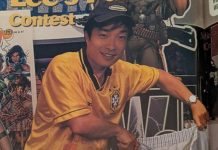by Rich Johnson
Twenty-three years ago I started at DC Comics. My job was to sell graphic novels to bookstores and libraries, anything that wasn’t a comic book shop. My first sales call was to Barnes & Noble. In 1997 there wasn’t a graphic novel section in any bookstore, let alone B&N. I ventured down from 1700 Broadway to the B&N offices at 17th and Fifth. I had two meetings set up, one with the science fiction, fantasy, role playing and graphic novel buyer and one with the humor buyer. Back then DC had a line of books called The Big Books. The first published was The Big Book of Urban Legends and they were bought by the humor buyer. So, my very first meeting was with a buyer named Jim — the graphic novel buyer. Before I even sat down in his cube, he said to me, “Graphic novels are dead.”
To be honest, he wasn’t wrong. I would find out from buyers all across the country that no one gave a shit about graphic novels. But there were a few glimmers of hope that day. I was selling the trade of Kingdom Come by Alex Ross and Mark Waid and the buyer who just told me that graphic novels were dead, and basically the job I took would probably end very soon, bought 3,000 copies. The other glimmer of hope was that the other buyer I was meeting with that day was also named Jim.
After I left Jim from Earth One, I ventured over to sell to Jim from Earth Two. I quickly realized he was a fan of comics. We had a good meeting; I thanked Jim for the meeting and left the building, wondering what was going on with my career.
Luckily, the Jim from Earth One left B&N and Jim from Earth Two took over science fiction, fantasy, role playing games and graphic novels. His name was Jim Killen. This change of buyers was a pivotal moment in the evolution of the comics medium and the format of graphic novels. Unfortunately, Jim is no longer at B&N, the victim of mass layoffs. You probably read the story right here.
Until last week, most people in comics had no idea who Jim Killen is. To highlight that point, a few years ago he was on a website’s 100 Most Powerful People in comics and someone commented, “Who the fuck is Jim Killen?” I am here to tell you who the fuck Jim Killen is and what he accomplished as a buyer.
Jim took categories that were considered the bottom of the barrel in publishing and he elevated them; Science Fiction, Fantasy, Role Playing and Graphic Novels. These categories were not taken seriously by many people in the world of publishing. Only geeks and nerds read comics and science fiction. Only the outcasts played Dungeons & Dragons. Because Jim loved books and was a fan, he took his job seriously. He admired the authors and artists that created these worlds.
Over the years, I often hear that chain book buyers aren’t really fans of books; they’re just cogs in the corporate machine. That’s just not true. The majority of buyers I have met who work at bookstore chains are as devoted to books as any independent book shop or comic shop.
At DC, when I started presenting titles to Jim, they were collected editions. There weren’t a lot of original graphic novels back then. Most of the time he would have already read the single issues and was already familiar with the story. Keep in mind that it’s impossible for buyers to read everything presented to them. He was making an effort to keep up with comics. He saw the potential in the format and the medium.
Whenever possible, I would try to arrange parties, including events at BookExpo, where I’d have book buyers and talent get together. Jim would have the chance to talk to the likes of Frank Miller, Kyle Baker, Neil Gaiman and Brad Meltzer. He would leave these get-togethers beaming at having had the chance to talk to writers and artists. I know this extended to science fiction and fantasy writers as well. He would talk of the annual breakfast he would have with George R.R. Martin at San Diego Comic Con. That was until the HBO show took off and everyone wanted time with the author. Talking to Jim about books, you could always see his enthusiasm, excitement and the sheer joy he got out of the books. These qualities helped him fight to get these categories the attention they deserved by a big chain.
Because of his support, books like Sandman, Y the Last Man, Fables, and so many others were put on the store’s shelves. Because of Jim, authors like Kim Harrison, George R.R. Martin, Wesley Chu, Neil Gaiman, Majorie Liu and so many others were enthusiastically supported at B&N.
Jim was a fan with power — the power to take chances on books and talent, because he knew that there were other fans out there like him. He elevated the categories enough that publishers started to market science fiction books as “elevated science fiction.” This meant that some publishers thought they had books that, while science fiction, were at a higher level and deserved to be sold into the general fiction section. Two titles that were part of this are Robopocalypse: A Novel and Ready Player One. If you know these titles, they are clearly both science fiction.
I would often bring Jim into my class at Pace University where I teach two courses in their graduate publishing program. One is on sales and distribution and the other is their publishing 101 class. I do a mock sales presentation and I make up a bunch of books to present to him. One year, I told him that Alex Ross and Mark Waid were returning to the world of Kingdom Come. It would focus on the child that Superman and Wonder Woman were pregnant with at the end of the original book. The child would be a girl and the book would chronicle her living in the shadow of her parents, while trying to bring her own code of moral justice to a world very different than the one her parents knew. Jim asked me if there was any way I could make that happen. I was long gone from DC, but I could see that look of excitement in his eyes. He could sell a lot of those.
So, to whoever asked “Who the fuck is Jim Killen?” if that doesn’t answer your question, call me. Jim Killen changed pop culture. He made being a fan of sci fi/fantasy, comic books and role-playing games cooler. He gave them the respect they deserved because he was one of them. Under his watch, these sections grew. In 2015 B&N doubled the size of their graphic novel section. That wouldn’t have happened without Jim Killen.









Classy bleeding cool style headline…oh wait, that pos is writing here now? What have we come to?
This is Johnson, not Johnston.
“That wouldn’t have happened without Jim Killen”, maybe?
I appreciate that you’re trying to educate people on an important individual in comics, but the title is horrible, the Earth-1/Earth-2 language is confusing, and this piece badly needed an editor. I mean.. come on. I love this site, but this article is abyssmal, even if well-intentioned.
Thank you for sharing the qualities that made the difference. Jim’s passion does shine through. It will be a loss for Barnes & Noble, and a gain for Jim’s next game plan. Whatever that may be, I wish him the best.
Regardless of syntax, or editing, it is a tribute to his contribution to the genre(s) and publishing. It needed to be said. Thank you!
You could argue that Stan Lee and Jack Kirby changed pop culture, or that George Lucas and Steven Spielberg changed pop culture (not always for the best). But Jim Killen? Don’t think so.
Comments are closed.